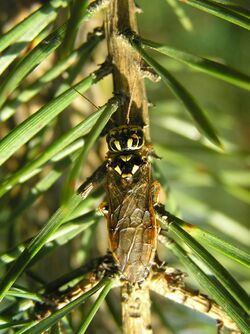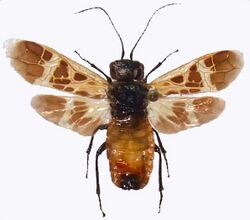Biology:Pamphilioidea
| Pamphilioidea | |
|---|---|

| |
| Acantholyda nemoralis (Pamphiliidae) | |
| Scientific classification | |
| Domain: | Eukaryota |
| Kingdom: | Animalia |
| Phylum: | Arthropoda |
| Class: | Insecta |
| Order: | Hymenoptera |
| Suborder: | Symphyta |
| Superfamily: | Pamphilioidea Cameron, 1890 |
| Families | |
|
Megalodontesidae Konow, 1897 | |
| Synonyms | |
|
Megalodontoidea Konow, 1897 | |
The Pamphilioidea are a small superfamily within the Symphyta (the sawflies), containing some 250 living species restricted to the temperate regions of Eurasia and North America. These hymenopterans share the distinctive feature of a very large, almost prognathous head, which is widest ventrally.
The superfamily contains two extant families. The Pamphiliidae are the leaf-rolling or web-spinning sawflies such as Acantholyda, Neurotoma, and Pamphilius whose larvae eat plants such as conifers; the adults have simple filiform antennae. The Megalodontesidae include genera such as Megalodontes and several fossil groups. Their larvae eat herbaceous plants, while the adults have serrate or pectinate antennae.[2]
References
Bibliography
- Aguiar, Alexandre P.; Deans, Andrew R.; Engel, Michael S.; Forshage, Mattias; Huber, John T.; Jennings, John T.; Johnson, Norman F.; Lelej, Arkady S. et al. (30 August 2013). "Order Hymenoptera". Zootaxa 3703 (1): 51–62. doi:10.11646/zootaxa.3703.1.12. PMID 26146682., in Zhang, Z.-Q. (ed.) Animal Biodiversity: An Outline of Higher-level Classification and Survey of Taxonomic Richness (Addenda 2013)
- Rasnitsyn, Alexandr P.; Zhang, Haichun & Wang, Bo (2006): Bizarre fossil insects: web-spinning sawflies of the genus Ferganolyda (Vespida, Pamphilioidea) from the Middle Jurassic of Daohugou, Inner Mongolia, China. Palaeontology 49(4): 907-916. doi:10.1111/j.1475-4983.2006.00574.x PDF fulltext
- Wang, Mei; Rasnitsyn, Alexandr P.; Li, Hu; Shih, Chungkun; Sharkey, Michael J.; Ren, Dong (June 2016). "Phylogenetic analyses elucidate the inter-relationships of Pamphilioidea (Hymenoptera, Symphyta)". Cladistics 32 (3): 239–260. doi:10.1111/cla.12129. PMID 34736302.
- Wang, M.; Rasnitsyn, A.P.; Yang, Z.; Shih, C.; Wang, B.; Ren, D. (2017). "Mirolydidae, a new family of Jurassic pamphilioid sawfly (Hymenoptera) highlighting mosaic evolution of lower Hymenoptera". Scientific Reports 7: 43944. doi:10.1038/srep43944. PMID 28266631.
Wikidata ☰ Q19896587 entry
 |


